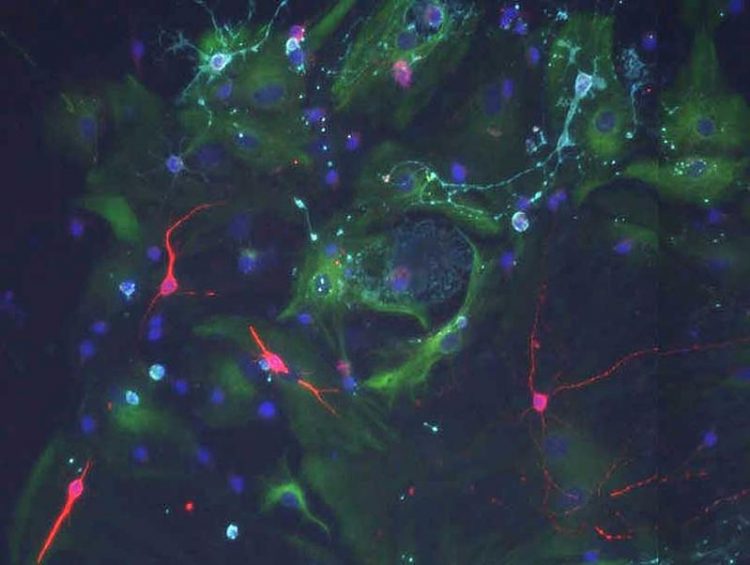Cerebrospinal fluid signals control the behavior of stem cells in the brain

When stem cells from the old brain are cultured with signals of a young choroid plexus they can divide and form new neurons (red). Biozentrum, University of Basel
Stem cells are non-specialized cells found in different organs. They have the capacity to generate specialized cells in the body. In the adult brain, neural stem cells give rise to neurons throughout life. The stem cells reside in unique micro-environments, so-called niches which provide key signals that regulate stem cell self-renewal and differentiation.
Stem cells in the adult brain contact the ventricles, cavities filled with cerebrospinal fluid (CSF) that bathes and protects the brain. The CSF is produced by the choroid plexus. The research team led by Prof. Fiona Doetsch at the Biozentrum of the University of Basel has now shown that the choroid plexus is a key component of the stem cell niche, whose properties change throughout life and affect stem cell behavior.
Choroid plexus signals regulate stem cells
Fiona Doetsch’s group uncovered that the choroid plexus secretes a wide variety of important signaling factors in the CSF, which are important for stem cell regulation throughout life. During aging, the levels of stem cell division and formation of new neurons decrease.
The research team showed that although stem cells are still present in the aged brain, and have the capacity to divide, they do so less. “One reason is that signals in the old choroid plexus are different. As a consequence stem cells receive different messages and are less capable to form new neurons during aging. In other words, compromising the fitness of stem cells in this brain region”, explains Violeta Silva Vargas, the first author of the study.
“But what is really amazing is that when you cultivate old stem cells with signals from young fluid, they can still be stimulated to divide – behaving like the young stem cells”.
A new path to understand brain function in health and disease
In the future, the research team plans to investigate the composition of the signaling factors secreted by the choroid plexus, as well as how these change in different states and affect neural stem cells. This could provide new paths for altering brain function in health and disease. “We can imagine the choroid plexus as a watering can that provides signals to the stem cells. Our investigations also open a new route for understanding how different physiological states of the body influence stem cells in the brain during health and disease, and opens new ways for thinking about therapy”, says Fiona Doetsch.
Original article:
Violeta Silva-Vargas, Angel R. Maldonado-Soto, Dogukan Mizrak, Paolo Codega, Fiona Doetsch: Age-Dependent Niche Signals from the Choroid Plexus Regulate Adult Neural Stem Cells. Cell Stem Cell, published online 21 July 2016.
Further Information:
Heike Sacher, University of Basel, Biozentrum, Communications, Tel. +41 61 267 14 49, email: heike.sacher@unibas.ch
Media Contact
More Information:
http://www.unibas.chAll latest news from the category: Life Sciences and Chemistry
Articles and reports from the Life Sciences and chemistry area deal with applied and basic research into modern biology, chemistry and human medicine.
Valuable information can be found on a range of life sciences fields including bacteriology, biochemistry, bionics, bioinformatics, biophysics, biotechnology, genetics, geobotany, human biology, marine biology, microbiology, molecular biology, cellular biology, zoology, bioinorganic chemistry, microchemistry and environmental chemistry.
Newest articles

Superradiant atoms could push the boundaries of how precisely time can be measured
Superradiant atoms can help us measure time more precisely than ever. In a new study, researchers from the University of Copenhagen present a new method for measuring the time interval,…

Ion thermoelectric conversion devices for near room temperature
The electrode sheet of the thermoelectric device consists of ionic hydrogel, which is sandwiched between the electrodes to form, and the Prussian blue on the electrode undergoes a redox reaction…

Zap Energy achieves 37-million-degree temperatures in a compact device
New publication reports record electron temperatures for a small-scale, sheared-flow-stabilized Z-pinch fusion device. In the nine decades since humans first produced fusion reactions, only a few fusion technologies have demonstrated…





















